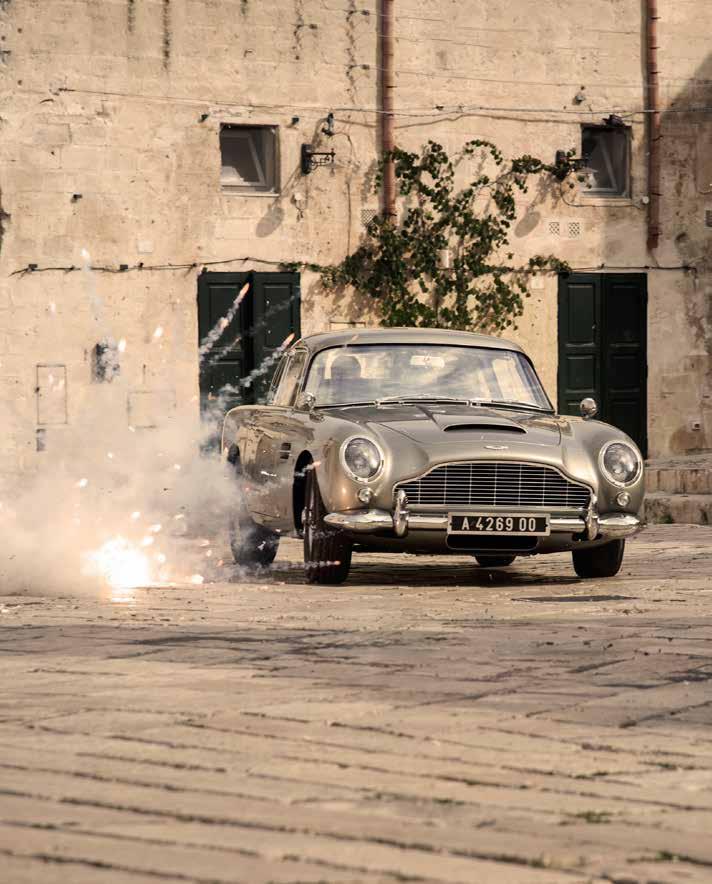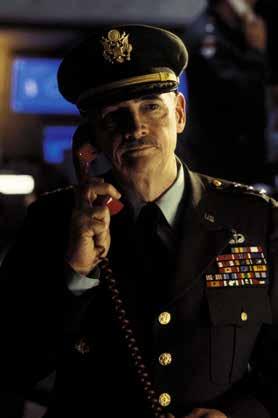
9 minute read
Dr. No To No Time To Die
FROM DR. NO TO NO TIME TO DIE
It is 60 years since James Bond made his cinematic debut, an anniversary which will be marked with special events and displays at the Club in October.
Advertisement
Michael G Wilson, Club member and producer of 15 Bond films to date, shares his memories of six remarkable decades.
Words by Timothy Barber Images courtesy of EON Productions
“HAS A FILM character ever been introduced better than that?” asks Michael G Wilson, the producer of 15 Bond films to date, safe in the knowledge that the answer, even after six decades, is emphatically ‘no’. Of course you know the scene he’s referring to: amid the glamour of a cardroom in Mayfair’s Les Ambassadeurs club, Miss Sylvia Trench enquires as to the name of her unseen chemin de fer sparring partner. Lighting a leisurely cigarette, Sean Connery gives his immortal three-word answer, as the first notes of Monty Norman’s theme thrum into posterity…

Below: Bond and Professor Dent in Dr. No, just before 007 shoots him
Dr. No, the film that launched James Bond into the cinematic firmament, was released in October 1962. Rewatching it today, it’s astonishing to be reminded just how much of the Bond iconography was there from the very start. The gun barrel title sequence; the stupendous set design by another long-term member of the Club, Ken Adam (still referenced, for instance, in the cavernous villain’s lair of last year’s No Time to Die); the dry humour (“I think they were on their way to a funeral,” Bond quips after sending hearse-driving assassins to a fiery end down a cliff-side); the dizzying locations; the shaken-not-stirred vodka martini. And of course, the Bond Girl, whose appearance with Ursula Andress emerging from the sea is as seminal as Bond’s.
But, according to Club member Michael G Wilson, if you really want to know how Dr. No broke the cinematic mould, shocking and enthralling audiences in

equal measure, you have to look to the fate of Professor Dent, the hapless agent of the titular villain. Bond, seated and at ease with a cigarette dangling from his lips, shoots Dent in cold blood, knowing the professor’s gun is empty. It’s a brutal, stunning moment.
“That was something that no hero had ever done in any film,” Wilson says. “It’s the ambiguity of this hero. Bond is a thug in a way, but a very polished one – the assassin who has this incredible charisma and style. That created a whole new genre of filmmaking – it was a total departure, and they did it with panache.”
Wilson had a ring-side seat, even then. Now 80, he was a college student when his stepfather, the movie producer Albert R ‘Cubby’ Broccoli, brought James Bond to the big screen. Broccoli, who had married Wilson’s mother Dana in 1959, teamed up with Harry Saltzman, a Canadian impresario who owned the rights to Ian Fleming’s novels, securing funding from United Artists to make Dr. No on a slim budget.
“I went with Cubby and Dana to the screenings, and I knew immediately we had a tiger by the tail,” Wilson says, referencing a phrase he says was a favourite of Broccoli’s himself once Bond became a household name. “It was a huge chance that they took, but it turned out that United Artists loved it and wanted to work with them.”
So too did some of the most seasoned British filmmakers of the time. Bond would be based at Pinewood Studios in Buckinghamshire and, as Wilson points out, Broccoli’s masterstroke was not just to make a film, but to establish a team of cinematic talents – production designer Ken Adam, director Terence Young, writer Richard Maibaum – who would take Bond forwards together as the budgets and box office took off. “That team stuck together, and there were crews that stayed on for decades,” he says. “That teamwork and sense of family that Cubby and Harry inspired has carried through ever since.”
Indeed, the Bond franchise is just about unique within Hollywood in remaining a family-led, and substantially family-owned, endeavour. EON Productions, the British company established in 1961 by Broccoli and Saltzman, still makes the James Bond films, led by Wilson and his sister Barbara Broccoli (daughter of Cubby and Dana); they also co-own, with MGM, the rights to Bond films past, present and future.
In other words, if you have any queries, quibbles, nit-pickings, requests or suggestions regarding Bond films and the decisions behind them, Wilson and Barbara Broccoli, sole stewards of the franchise since 1995’s GoldenEye, are the people to take them to. And of course, as Wilson readily acknowledges, the thing about Bond is that everyone has an opinion. “It’s like Sherlock Holmes,

The British company EON Productions still makes the James Bond films, led by Wilson and his sister Barbara Broccoli.
Above: Michael G Wilson with Barbara Broccoli

Superman, Batman… Bond is one of these fictional characters that’s become part of the national consciousness and language – people say something’s ‘Bondian’, and you know what they mean. People feel possessive of it.”
And, of course, nowhere is the task bigger or the opinions stronger than around the selection of an actor to take on the 007 mantle – a job presumably looming large in Wilson’s ‘pending’ tray, following Daniel Craig’s No Time to Die exit, not that the producer is giving anything away. Craig, though, was transformative: an actor of both grit and subtlety, who was able to take things back to the essence of Ian Fleming’s literary creation while investigating Bond’s inner life and origin story in ways that once seemed anathema. “With an actor like Daniel Craig, you get a chance to explore the character in new ways that you didn’t feel you could before,” Wilson says. “It was an opportunity to go back to basics and recreate the Fleming Bond, and to explore the emotional life of Bond. You have to have an actor who can express that without complex dialogue, and he took it on in the most serious way.”
The huge responsibility of choosing Bonds and steering the franchise wasn’t always something Wilson planned on. An engineering graduate, he studied law at Stanford before joining a Washington legal firm, eventually specialising in tax affairs and becoming a partner. But inexorably, his professional pathway led back to 007. When co-producer Saltzman withdrew from EON and the Bond movies in the mid1970s, Cubby brought Michael in to help with the legalities. “By the time we did The Spy Who Loved Me [the 1977 blockbuster that reinvigorated the series], I was very involved in the filmmaking and developing the story.”
Having come from a family of actors (his father, Lewis, was the first person to portray Batman on screen), it was a world he was well used to anyway. As a young engineering graduate, he would visit the Bond sets and help out, which is how one of the more arcane bits of Bond lore came about: the blink-and-you-miss-it Michael G Wilson cameo. Wilson has had a walkon or voiceover part in almost every film since The Spy Who Loved Me – a bit of fun that has become, as he describes it, “almost like a lucky charm”, and something fans love spotting: as a tourist in Moonraker, on a video conference call in Tomorrow Never Dies, or reading a newspaper in a hotel lobby in Quantum of Solace.
His very first appearance was back in 1964’s Goldfinger, in which he’s one of Auric Goldfinger’s snappily-dressed militia raiding Fort Knox. “I was just working for a couple of weeks on location, and I was pressed into service because we had to

The Aston Martin DB5 first featured in 1964’s Goldfinger. Here, a stunt version is seen on the set of the most recent Bond film, No Time to Die, 2022


have people to don the costumes,” he says. “I was in the long shots; but I was also a runner and a third assistant director. I was doing a job.”
Eventually, the one-time runner and extra was not only co-producing the Bond movies alongside his stepfather (and later his sister Barbara) but writing them too. In tandem with long-time scribe Richard Maibaum, Wilson penned the scripts for all Bond’s 1980s outings, as developments like the impact of perestroika, the rise of Silicon Valley and Russia’s war in Afghanistan all filtered through the storylines. Wilson notes wryly that the longstanding intention to reflect global developments has, in one instance, proven stunningly prescient lately. A scene he and Maibaum wrote for 1983’s Octopussy features Steven Berkoff’s depraved Russian general mapping out a paranoid plan to attack Europe, scoffing at the idea of NATO ever fighting back. With grim predictability, the scene recently went viral on YouTube. “I didn’t think anyone would dredge it up again, but they did,” says Wilson. “He talks about the West being decadent and divided, and not having the stomach to risk Russian atomic reprisals. When people say Bond is timeless – unfortunately that scene is timeless. Life imitating art….”
Wilson may no longer be writing the scripts, but he has helped transform Bond into an all-conquering box office colossus, that in recent outings has explored new emotional depths and evermore elaborate narrative arcs, while still hanging onto the blueprint laid down 60 years ago. Nevertheless, given the apparent full-stop thrown up by the ending of No Time to Die, navigating the next step in the series may be the most consequential moment in the Bond saga since Cubby Broccoli and Harry Saltzman first shook hands. That’s assuming there is to be a next step…
“We don’t have any plans at this time for continuation because we are busy celebrating our 60th anniversary. We have a music documentary, auctions, and of course we’re going to put a lot of cars in Pall Mall. We’re concentrating on that.”
And anyway, as he admits elsewhere in our conversation, Bond belongs as much to its fans as it does to his family or any film studio. “The Bond audience is incredibly enthusiastic, and you have a responsibility towards that. You don’t want to be the person who killed off James Bond.” Thank goodness for that.
Position: CaptionAt audi ducia sundestiam aut diae dem aria nem quo verrum eum facilignis Michael G Wilson in Die Another Day
The next step may be the most consequential moment since Broccoli and Saltzman first shook hands.
Throughout October original cars from the Bond films will be displayed in the rotunda at Pall Mall alongside a selection of memorabilia kindly loaned by EON, and there will be a spectacular Bond-themed dinner in the Great Gallery. Full details will be announced in The Club Wire and on the Club website.








